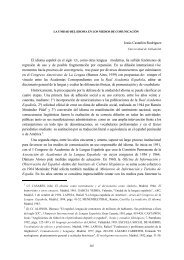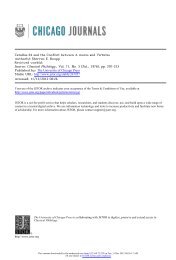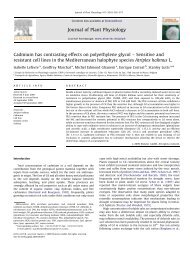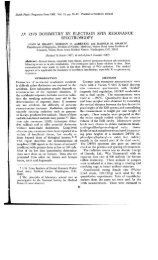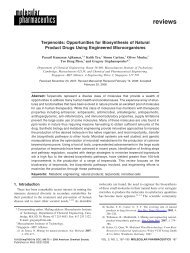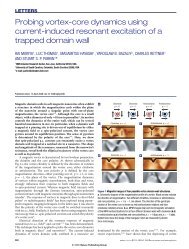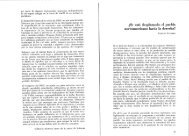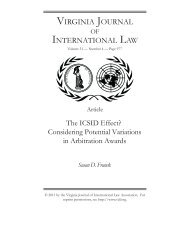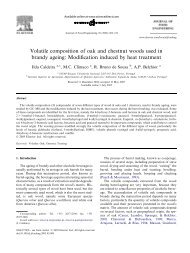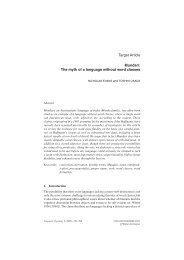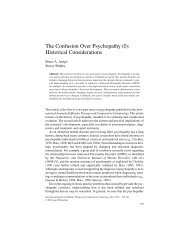Colorimetric Method for Determination of Sugars and Related ...
Colorimetric Method for Determination of Sugars and Related ...
Colorimetric Method for Determination of Sugars and Related ...
You also want an ePaper? Increase the reach of your titles
YUMPU automatically turns print PDFs into web optimized ePapers that Google loves.
VOLUME 28, NO. 3, MARCH 1956<br />
move in discrete b<strong>and</strong>s, <strong>and</strong> how much margin should be allowed<br />
along the edges. The larger the amount <strong>of</strong> sugars which can be<br />
added, the less significance the blank will have. In most cases<br />
about 600 to 1000 y <strong>of</strong> sugar should be added. Dimler <strong>and</strong> others<br />
(IS) recommend that another paper be prepared to counteract<br />
the variations in delivery that may occur with micropipets. To<br />
this paper they add st<strong>and</strong>ard amounts <strong>of</strong> known sugars, using<br />
the same pipet <strong>and</strong> the same technique. This procedure does<br />
not, <strong>of</strong> course, eliminate the need <strong>for</strong> a blank determination,<br />
because the presence <strong>of</strong> the soluble carbohydrate fraction in the<br />
filter paper will have a relatively greater effect at low sugar con-<br />
centrations. After the sugars have been added to the paper, the<br />
chromatograms are developed <strong>for</strong> a long enough period so that<br />
the sugars to be analyzed are clearly separated. After the<br />
chromatogram has been dried in the air, the side marking strips<br />
are cut <strong>of</strong>f <strong>and</strong> sprayed to show the location <strong>of</strong> the sugars in the<br />
center section. The center unsprayed portion <strong>of</strong> the chromato-<br />
gram is then cut up into sections corresponding to the locations <strong>of</strong><br />
the sugar. Each section is transferred to Petri dishes, beakers, or<br />
other suitable containers that can be covered or closed. The<br />
blank paper is cut up to correspond to the area <strong>and</strong> location <strong>of</strong><br />
the sugars <strong>of</strong> the other paper. Twenty milliliters <strong>of</strong> distilled<br />
water is added to each <strong>of</strong> the Petri dishes, which are then covered<br />
<strong>and</strong> allowed to st<strong>and</strong> <strong>for</strong> 30 minutes with occasional shaking.<br />
During this time the sugar becomes equally distributed through-<br />
out the liquid <strong>and</strong> solid phases (water <strong>and</strong> cellulose). The eluate<br />
is filtered through glass wool <strong>and</strong> the concentration <strong>of</strong> sugars<br />
determined as described be<strong>for</strong>e, with the important difference<br />
that the absorbance <strong>of</strong> the blank reading is subtracted from that<br />
corresponding to the sugar be<strong>for</strong>e referring to the st<strong>and</strong>ard curve.<br />
Results. EFFICIEXCY OF EXTRACTIO% OF SUGARS FROM FILTER<br />
PAPER. This is illustrated by two typical euperiments:<br />
1. With a micropipet, 0.102 ml. <strong>of</strong> a solution containing 4.52<br />
mg. <strong>of</strong> D-fructose was added to a piece <strong>of</strong> Whatman No. 1 paper<br />
(3 X 5 inches). The paper was allowed to dry in the air <strong>for</strong> 24<br />
hours <strong>and</strong> then soaked in 20 ml. <strong>of</strong> distilled water <strong>for</strong> 0.5 hour to<br />
extract the sugar. (In another series <strong>of</strong> experiments it was found<br />
2'oOl I .80<br />
Wl.2Ot- / /<br />
Y<br />
tf /<br />
' ' '<br />
.20y<br />
'! ' 40 80 120 160 26, ' 2iO<br />
I I<br />
MILLIGRAMS OF PHENOL<br />
280 ' 3;C<br />
Figure 10. Absorbance us. amount <strong>of</strong> phenol<br />
1. D-Fructose. 80 Y. Beckman ?.lode1 DU. 490 mu<br />
DU, 485 mr<br />
490<br />
355<br />
that sugars are extracted from the paper almost immediately.)<br />
The extract was filtered through glass wool <strong>and</strong> a 2-ml. aliquot<br />
<strong>of</strong> the filtrate added to 20 ml. <strong>of</strong> water. Two milliliters <strong>of</strong> this<br />
diluted solution was treated with 258.4 pl. <strong>of</strong> 80% aqueous phenol,<br />
followed by 5 ml. <strong>of</strong> concentrated sulfuric acid. The observed<br />
absorbance at 490 mp was 0.548 <strong>and</strong> 0.538.<br />
In a blank experiment a piece <strong>of</strong> paper <strong>of</strong> identical size was<br />
extracted <strong>for</strong> 0.5 hour with 20 ml. <strong>of</strong> water. A 2-ml. aliquot was<br />
treated with phenol <strong>and</strong> sulfuric acid as described above. The<br />
absorbance was 0.10 (average <strong>of</strong> three results). Hence, the ab-<br />
2<br />
sorhance correction <strong>for</strong> the blank = 0.10 X - = 0.01.<br />
22<br />
Corrected absorbance <strong>for</strong> the sugar determination = 0.54 -<br />
0.01 = 0.53. From the st<strong>and</strong>ard curve <strong>for</strong> fructose, an absorb-<br />
ance <strong>of</strong> 0.57 is equivalent to 42.4 y <strong>of</strong> sugar. There<strong>for</strong>e, the<br />
0.53<br />
amount <strong>of</strong> fructose equivalent to an absorbance <strong>of</strong> 0.53 = __<br />
0.57<br />
0 53<br />
X 42.4 y. Hence the total fructose recovered = X 42.4<br />
0.57<br />
20 22<br />
X - X - = 4336 y.<br />
2 2<br />
4336<br />
Recovery = T X 100 = 96%.<br />
4020<br />
2. A similar experiment carried out with D-glucose (400 y)<br />
added to a piece <strong>of</strong> paper (2 X 2 inches) gave a recovery <strong>of</strong> 100%.<br />
Additional experiments with D-mannose, D-xylose, <strong>and</strong> L-arabi-<br />
nose, <strong>and</strong> xith methylated sugars such as 2,3,4,6-tetra-o-methyl-,<br />
2,3,6-tri-o-methyl-, <strong>and</strong> 2,3-di-o-methy1-~-glucose with <strong>and</strong><br />
without solvent migration using phenol-water, butanol-ethanol-<br />
water, <strong>and</strong> methyl ethyl ketone-water azeotrope gave recoveries<br />
<strong>of</strong> 95 to 100%.<br />
ANALYSIS OF A SYXTHETIC MIXTURE OF SUGARS. (1) A solution<br />
containing D-fructose (3.18 mg.) <strong>and</strong> D-glucose (0.20 mg.)<br />
was transferred to a piece <strong>of</strong> Whatman No. 1 paper (8 X 22<br />
inches) as described previously. The chromatogram was developed<br />
<strong>for</strong> 24 hours by use <strong>of</strong> phenol saturated with water as the<br />
solvent. The paper was removed from the chromatographic<br />
chamber <strong>and</strong> allon-ed to dry <strong>for</strong> 24 hours. The marginal strips<br />
were cut <strong>of</strong>f <strong>and</strong> sprayed with p-anisidine trichloroacetic acid<br />
reagent (small amounts <strong>of</strong> phenol do not interfere). After reassembling<br />
the chromatogram, the best line <strong>of</strong> demarcation was<br />
drawn between the two spots <strong>and</strong> the sections were cut out (glucose,<br />
6 to 8.5 inches, fructose, 8.5 to 11 inches from the starting<br />
line), together with the corresponding blanks as previously described.<br />
The pieces <strong>of</strong> paper containing the two sugars <strong>and</strong> the<br />
tn-o blanks were extracted <strong>and</strong> filtered. The concentration <strong>of</strong><br />
the two sugars vias then determined by the phenol-sulfuric acid<br />
reagent, reference being made to st<strong>and</strong>ard curves <strong>for</strong> glucose <strong>and</strong><br />
fructose. The results mere as follows:<br />
Glucose Recovery<br />
Absorbance <strong>of</strong> the eluate (2 ml. out <strong>of</strong> 20 ml. removed <strong>for</strong><br />
test) 0.32<br />
;ibsorbance <strong>of</strong> blank 0 10<br />
;Ibsorbance <strong>for</strong> glucose 0 22<br />
From the st<strong>and</strong>ard curve <strong>for</strong> glucose absorbance, 0.45 = 42.4 y glucose<br />
0 22<br />
Absorbance <strong>of</strong> 0.22 = ~ X 42 4 y glucose<br />
0 45<br />
0 22 20<br />
Total glucose recovered = __ X 42 4 X - = 206 y glucose<br />
0 45 2<br />
Recovery = 103%.<br />
Fructose Recovery<br />
dbsorbance <strong>of</strong> eluate (diluted 2 ml. to 20 ml. <strong>of</strong> water) 0 40<br />
Absorbance <strong>of</strong> blank 0 01<br />
Absorbance <strong>for</strong> fructose 0.39<br />
From the st<strong>and</strong>ard curve <strong>for</strong> fructose absorbance, 0.57 = 42.4 y fruc-<br />
tose<br />
0.39<br />
Absorbance <strong>of</strong> 0.39 = 7 X 42 4 y fructose<br />
0.07



